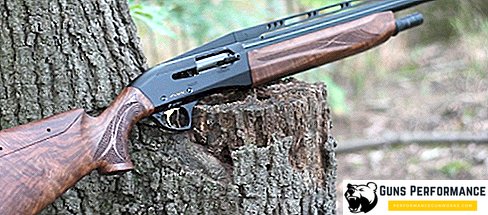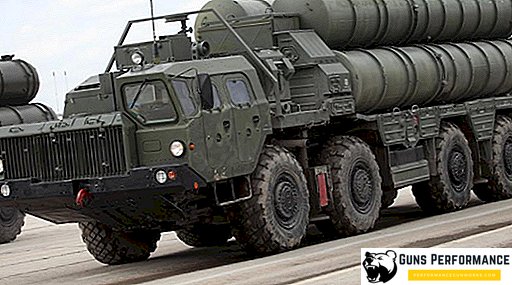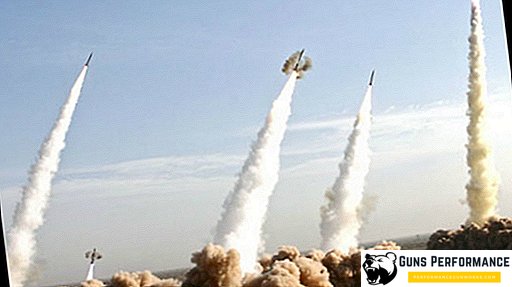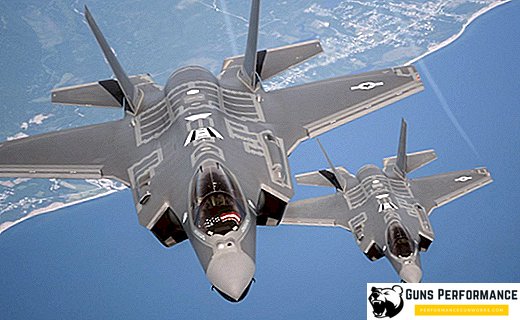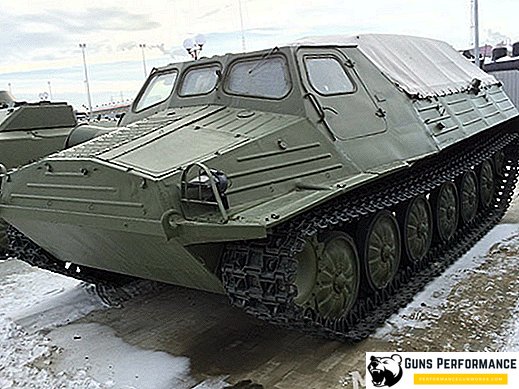Springfield M1903 - American-made magazine rifle, which was developed in the early 20th century. In 1903, it was adopted by the US Army. Half of the army used this weapon during World War II.
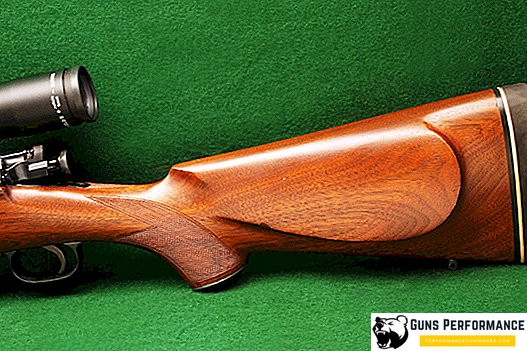
The history of design and serial release Springfield M1903
The US government came to the decision to create a new shop weapon after the war with Spain in 1898. The enemy’s armament (Mauser’s rifles) was significantly superior to the obsolete weapons of American soldiers. The engineers had the task to design a rifle with a sliding bolt. The basis was taken by Mauser, copies of which were captured during the last war with the Spaniards.
In 1903, a new weapon was adopted. It was fed from specially created cartridges. The designers tried to make maximum structural changes, but the company Mauser Werke sued the government of the country and received $ 3 million for violating the license.

Use of new ammunition for the Springfield M1903
The history of the .30-03 rounds ended in 1906, when the .30-06 was developed. They consisted of shell charges with a sharp end, the mass of which was 9.6 grams. To use new ammunition on rifles of the first years of production, the aiming mechanism had to be changed.
During the First World War, the United States Army experienced a shortage of M1903, so they adopted an overhaul of foreign Endield P-14 for charges .30-06. The main drawback of the instrument in those years was the processing of a poor-quality receiver. New technologies that appeared in 1918 helped to eliminate this disadvantage.

The appearance of modifications Springfield M1903
In 1929, the first improved version appeared, which received the A1 index. The main change is the appearance of a semi-pistol grip. The version was not widely adopted, since in 1936 the M1 Garand entered service.
During the Second World War, the States were experiencing a shortage of weapons, so they decided to resume the release of the M1903. Version A3 was different using stamped parts, and the usual sight gave way to a diopter sight. Production lasted 3 years (1942-1945). Some copies received a handle of an old sample.
On the basis of the A3 developed the first sniper rifle of American origin. She got A4. For an acceptable quality, we improved the processing of the stem (changed the processing technology to a higher quality). The standard aiming mechanism gave way to an optical sight.

Construction Springfield M1903
The central part of the weapon was the receiver. It housed the main mechanisms of the rifle. It consisted of two main parts:
- The first part is a polygonal box with a U-shaped section. Barrel mounted on the mount, located on the front wall. In the same place the handle of a recharge was located. This part was responsible for fastening the forearm (made of wood) and throwing out the cartridge cases of bullets through a special window;
- The second part was L-shaped, the lower plank was equipped with low sides. On top was a screw that was responsible for fastening both parts. Bottom positioned parts USM. On the back wall made a window for installing the store. The magazine was placed inside a stock made of wood. In addition to the screw, for fastening the two parts made a latch.
Inside the receiver, in addition to the trigger, there was a unique valve and return spring. The shutter is an oblong detail. Inside the gate made a channel designed for the drummer. Drummer was asymmetrical. The design feature is the interaction of the return spring and the shutter by means of a lever. The mechanism of direct interaction was absent.

Behind the bolt placed a lever of complex shape. Bottom on it made the mount for the return-combat springs. In the central part, interaction with the sear and trigger mechanism was carried out by means of a notch. The lower part of the receiver is allocated under the return-combat spring. It had a cylindrical shape and was supplemented with a guide rod.
The reloading system was developed from scratch, in the future it was used in some American rifles. Under the trunk placed a long rod, the main purpose of which - cocking mechanisms. The rod was in contact with all the details in the receiver after clicking on the head, which was located next to the forearm.
The device USM maximally simplified (consisted of several components). The trigger with a leaf spring was located inside the safety bracket. Sheeptalo limited the work of all nodes before the shot. For safety, there was a fuse that was activated by a button (located on the back of the bracket). In the active state limited the movement of the trigger.
Store tubular type was placed in the butt. For the tube through the entire butt made a channel of the appropriate diameter. Tray complex tube was in front of the tube. It was located inside the shutter lever window. To recharge the owner could get the phone. Store capacity - 10 ammunition.

Wood was used to make the forend and stock. Handguards received a U-shape. It protected the reloading rod from mechanical damage and protected the arrow from contact with the heated barrel. On the back of the butt there is a groove made because of the impressive size of the handle. On the accessories installed antabka for fastening the belt.
At the factory, the rifle was completed with a mechanical sighting mechanism. The muzzle part was equipped with a front sight, the rear part was equipped with a mechanical or ring sight. In the entire history of production, the structure of the sight changed many times in different models.

How does the Springfield M1903 work?
In order to charge the gun with cartridges, it was necessary to turn the magazine by the handle and get it. Each cartridge in the tube must be placed a bullet to the upper cut. After the store returned to its original place, the rod was pressed, as a result of which the mechanisms were cocked. Shooting took place with an open bolt that does not fit into the framework of the modern concept of guns.
After pressing the trigger from the lever-sear, a large lever was released that held the return spring. The spring had an effect on the lower arm of the lever. By means of the upper arm, the movement of the bolt to the most forward position began. During this time, ammunition was seized from the store, sent to the chamber. After contact with the drummer, a shot occurred.
The recoil after the shot contributed to the rollback of the shutter to its original position. The lever resumed swinging and squeezed the return spring. At this time, the cartridge case of the cartridge was removed from the chamber and thrown through a special window. When the shutter returned to its extreme rear position, the next shot could be fired.

Modifications Springfield M1903
In the history of the serial production of the rifle, the Springfield M1903 developed several modifications:
- M1903 1903 - fed on ammunition .30-03, equipped with a sector sight;
- M1903 1906 - fed on ammunition .30-06. The main changes include a new chamber and a new sighting mechanism, which allowed to hit targets at a distance of up to 2,700 yards;
- Mark 1 - Pedersen's mechanism was added to the design, which allowed the use of "weak" ammunition. It replaced the classic shutter. The capacity of the store increased to 40 charges. USM and store cutter improved. The history of the model ended with the complete utilization of all copies;
- NM - sports option. Innovative (in those years) high-precision technologies were used in production. The overall quality of the design differed from the basic version for the better;
- Air Service - modification for the air force with a 25-round magazine;
- A1 - an improved version with a half-pistol grip and a modified scope;
- A2 - characterized by the presence of an adapter for the 76-millimeter cannon;
- A3 - a simplified model with stamped parts, produced during the Second World War;
- A4 - the first American-made sniper rifle, developed on the basis of A3.
In our years, it is difficult to find a person using Springfield M1903. Copies in acceptable condition adorn the collections of weapons lovers.

Operation geography
The famous rifle was used not only in the American army, but also exported to other countries:
- France - received several batches of rifles in support of the Allied countries during the Second World War. In the future, the remaining copies used in the war in Indochina;
- Great Britain - after the start of the Second World War, the country's production facilities could not provide the army with the necessary volume of weapons, therefore M1903 was ordered from the USA;
- Third Reich - captured models were used as captured rifles;
- Vietnam - as a capture weapon (captured by the party in the war in Indochina);
- Cuba - from the beginning of the mass production until 1959 were delivered under the terms of the military support of the army of F. Batista;
- Nicaragua - in the 20-30s of the last century, were used by units of the National Guard. The remaining copies in the future entered service with detachments of the local police;
- Korea received several parties after World War II under the military support program.
High demand for a rifle is based on low cost, simple and reliable design, as well as high efficiency and accuracy.

What can be concluded?
Springfield M1903 - a weapon with a rich history that helped many countries during the First and Second World Wars. Of the huge number of copies produced in the "living" there are only a few dozen units that are in museums and private collections.


